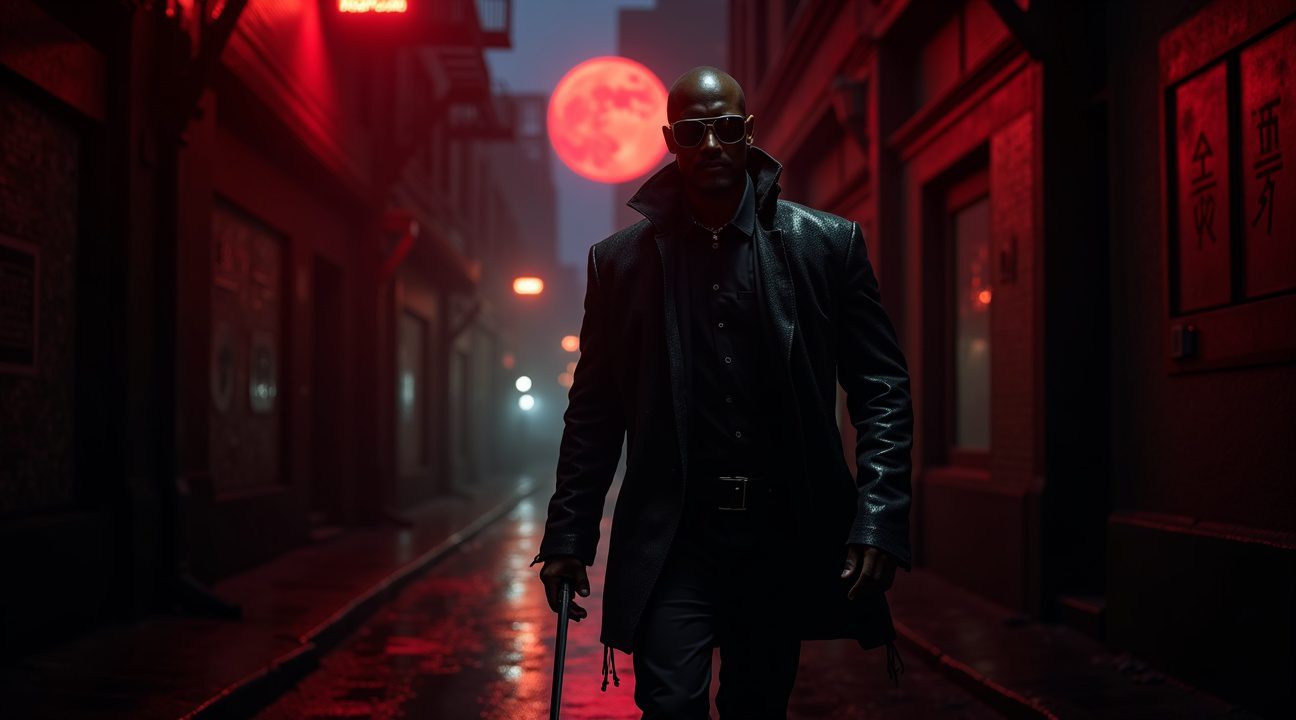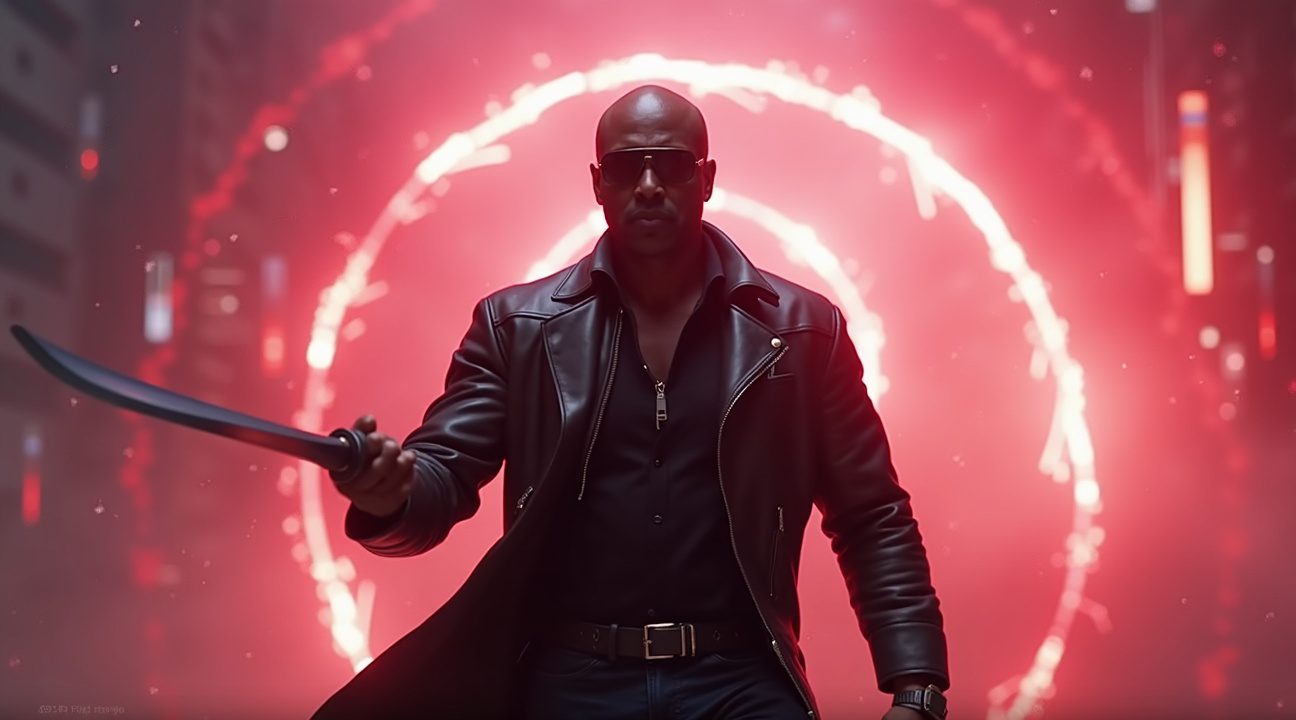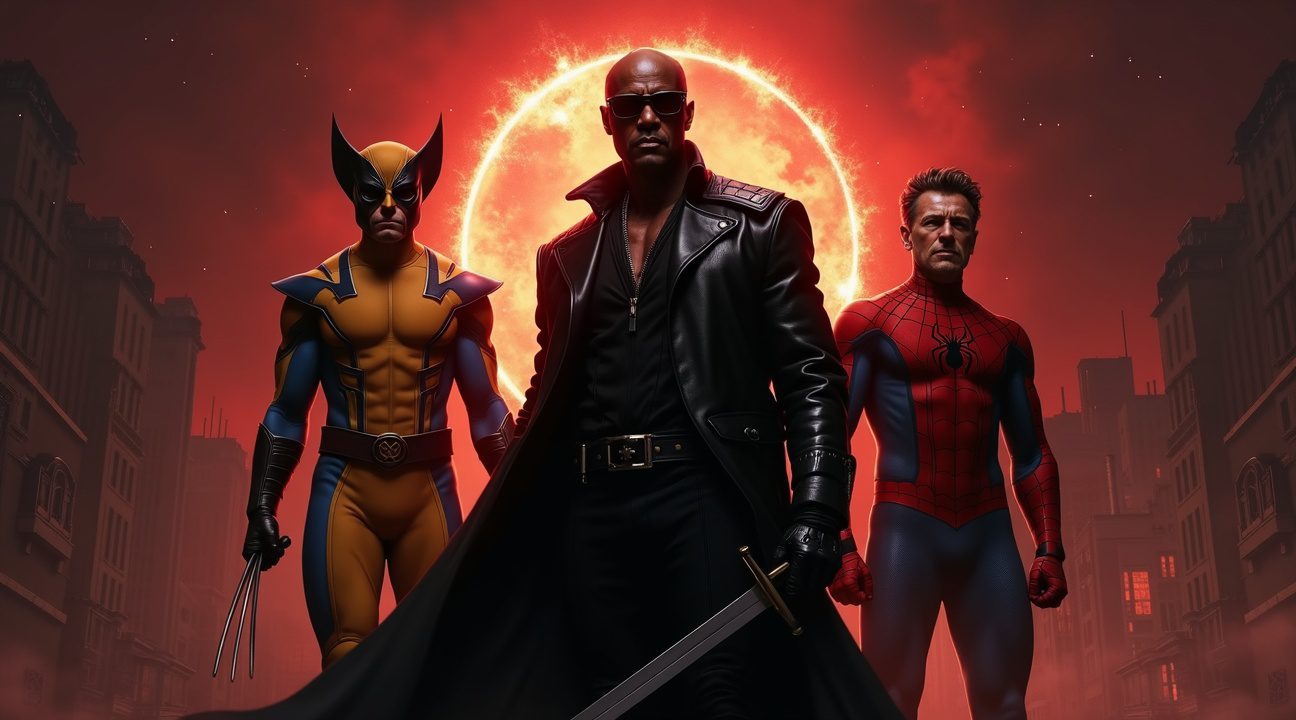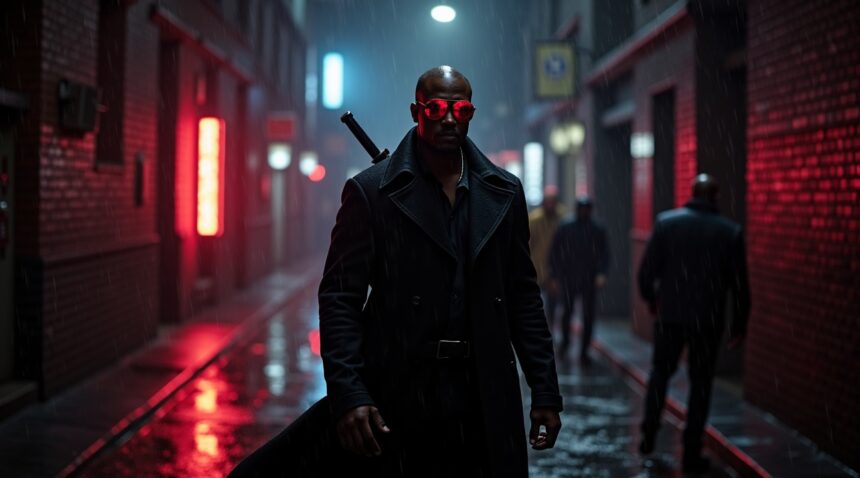Wesley Snipes has officially secured his return to the Marvel Cinematic Universe as Blade, with confirmed involvement in multiple upcoming projects including the highly anticipated Avengers: Secret Wars.
This comeback marks a dramatic shift from his previously strained relationship with Marvel Studios, demonstrating how his impressive performance in Deadpool & Wolverine successfully repaired professional bridges and opened doors for an expanded MCU role.
Key Takeaways
- Wesley Snipes is confirmed to return as Blade in Avengers: Secret Wars and four to five additional Marvel projects spanning both live-action films and animated series.
- His successful appearance in Deadpool & Wolverine served as the catalyst for Marvel Studios to rebuild their relationship with the actor after previous production disputes.
- Marvel’s dual-Blade strategy allows both Snipes and Mahershala Ali to coexist within the multiverse framework, with Snipes potentially serving as a mentor figure.
- The original Blade trilogy’s $415 million worldwide box office success and cultural impact helped establish the template for R-rated superhero films and darker comic book adaptations.
- Snipes joins other legacy Marvel actors like Hugh Jackman and Tobey Maguire who have returned to their iconic roles through multiverse storytelling.
The Significance of Snipes’ Blade Return
Snipes’ return represents more than nostalgia. His Blade character carries significant weight in superhero cinema history. The original trilogy predates the modern Marvel boom by nearly a decade and proved that comic book properties could thrive with mature themes and violent content.
Marvel Studios recognizes this legacy. Their decision to bring Snipes back reflects careful consideration of fan expectations and commercial potential. His cameo in Deadpool & Wolverine generated a massive positive response. This reaction convinced executives that Snipes still commands substantial drawing power.
The Role of the Multiverse
The multiverse concept provides perfect narrative flexibility for this return. Marvel can preserve continuity for Ali’s upcoming Blade film while honoring Snipes’ original portrayal. This multiversal approach satisfies different audience segments without contradictions.
Snipes’ Involvement Across Platforms
Production insiders reveal that Snipes will appear in various capacities across his contracted projects. This includes both extensive roles and brief, impactful appearances. Such a strategy allows maximum exposure without disrupting the focus of the central narrative in each project.
His Deadpool & Wolverine performance proved Snipes has retained his signature edge. Critics and fans alike praised his brief appearance for intensity and authenticity, solidifying the case for his expanded involvement in the MCU.
Cross-Generational Appeal and Legacy Value
Marvel’s evolving business model increasingly embraces legacy characters to bridge generational gaps. Snipes fits seamlessly within this framework, linking early 2000s superhero films with modern MCU titles. This strategy strengthens long-term fan investment.
Financially, the move is smart. The Blade films earned robust returns during their initial theatrical run. With multiverse nostalgia surging, Snipes’ return is seen as a low-risk, high-reward decision that may draw both old and new fans.
Pushing Representation Forward
Beyond box office figures, Snipes’ Blade was groundbreaking for Black representation in superhero cinema. By reintroducing him, Marvel reinforces its commitment to diversity while honoring the cultural achievements of past comic book films.
Expanding Across Media Formats
The actor’s upcoming roles won’t be limited to live-action. Snipes is also involved in unspecified animated projects, granting Marvel more creative freedom to explore deeper dimensions of Blade’s character in varying visual styles and storytelling tones.
Setting the Stage for Other Legacy Returns
Snipes’ successful reintegration creates a precedent for Marvel to revive other pre-MCU actors. This opens the door for a wider range of storytelling possibilities and cast diversity across upcoming phases of the franchise.
The Importance of Timing
The announcement of Snipes’ return coincides with Marvel’s growing multiverse expansion. As Avengers: Secret Wars nears, his inclusion underscores the film’s scope and its connection to past and present Marvel eras.
Snipes’ return also serves as a real-world case study in reconciliation. Despite historic tensions, Marvel Studios’ decision to reengage with him indicates a forward-thinking, pragmatic approach to talent collaboration and franchise growth.
Future Impact and Franchise Evolution
Snipes’ confirmed participation in several upcoming projects signifies long-term investment in his iteration of Blade. Marvel’s commitment to his expanded presence shows confidence in his character’s commercial and cultural value.
The dual-Blade approach, retaining both Snipes and Ali, showcases franchise innovation. Rather than replacing one portrayal with another, Marvel is embracing multi-interpretation storytelling. This model could shape how the studio manages other iconic superheroes moving forward.
Ultimately, the return of Wesley Snipes as Blade reaffirms the lasting power of a well-crafted superhero character. Decades after his debut, Snipes continues to resonate with audiences, proving how strong performances and thoughtfully developed roles can endure across generations and cinematic shifts.
Wesley Snipes’ Triumphant MCU Return Confirmed for Avengers: Secret Wars
Wesley Snipes has officially secured his place back in the Marvel Cinematic Universe, with confirmed reports indicating his return as Blade for future projects, including the highly anticipated Avengers: Secret Wars. This development marks a significant shift from his previous strained relationship with Marvel Studios, demonstrating how a single performance can reshape an entire franchise trajectory.
The veteran actor’s recent appearance in Deadpool & Wolverine served as the catalyst for this renewed partnership with Marvel Studios. His portrayal of the iconic Daywalker left such a strong impression on executives that they immediately began exploring opportunities to integrate him into their expanding multiverse narrative. Sources close to the production reveal that Snipes’ professionalism and commitment during the filming process helped repair bridges that were previously burned during earlier production disputes.
Multi-Project Marvel Commitment Spans Live-Action and Animation
Marvel Studios has reportedly committed to featuring Snipes in four to five upcoming projects, extending far beyond just the next Avengers installment. This comprehensive approach includes both live-action films and animated series, showcasing the studio’s confidence in his ability to carry the Blade legacy forward. The decision reflects Marvel’s strategy of leveraging proven talent while building connections between different corners of their cinematic universe.
Fan reception has been overwhelmingly positive since news of his return broke, with social media platforms buzzing with excitement about seeing the original Blade interact with current MCU heroes. This enthusiastic response likely influenced Marvel’s decision to expand his role beyond a simple cameo appearance. The studio recognizes that Snipes brings both nostalgic appeal and genuine acting credibility to their vampire-hunting character.
The timing couldn’t be better for both parties involved. Marvel continues to explore supernatural elements within their universe, making Blade’s inclusion feel organic rather than forced. For Snipes, this represents an opportunity to reclaim a character he helped establish in the late 1990s, potentially introducing him to an entirely new generation of fans who discovered him through recent gaming developments.
Industry insiders suggest that Marvel’s approach with Snipes demonstrates their willingness to work with legacy actors who understand their characters intimately. This strategy contrasts sharply with their previous attempts to completely reboot the Blade franchise with different actors, including the ongoing search for directors for various Blade projects that have faced multiple delays.
Snipes’ confirmed involvement in Avengers: Secret Wars positions him as a key player in what many expect to be one of Marvel’s most ambitious crossover events yet.

Mahershala Ali’s Blade Reboot Faces Continued Production Setbacks
Marvel’s highly anticipated Blade reboot starring Mahershala Ali has encountered another significant roadblock, with the film being completely removed from the studio’s official release calendar. Originally slated for a November 2025 debut, the project now sits in production limbo after five grueling years of development challenges.
The journey began promisingly when Ali was first announced as the new Blade at San Diego Comic-Con in 2019. Fans erupted with excitement, expecting the Academy Award-winning actor to breathe fresh life into the vampire hunter franchise. However, the project has since become synonymous with delays, script rewrites, and directorial changes that have plagued its development cycle.
Production Challenges Mirror Industry-Wide Issues
The Blade reboot’s struggles reflect broader challenges facing modern superhero productions. Multiple script rewrites have forced the project back to square one repeatedly, while changing directors have created inconsistent creative visions. These setbacks have pushed the film’s timeline across 2023, 2024, and now into an undefined future release window.
I’ve observed that these production issues stand in stark contrast to the original Blade trilogy’s relatively smooth development:
- Blade (1998)
- Blade II (2002)
- Blade: Trinity (2004)
These films maintained consistent momentum that kept audiences engaged. The original trilogy’s success makes the current reboot’s challenges even more pronounced, especially with rumors of a Blade game in development that could potentially launch before the film.
Ali’s commitment to the role remains strong despite the obstacles. The actor has publicly expressed his dedication to bringing the character to life within the MCU framework. However, Marvel’s decision to remove the film from their release schedule suggests the studio recognizes that rushing production would compromise the final product’s quality.
The removal from Marvel’s release calendar represents more than just another delay—it signals that the studio is taking a step back to fundamentally reassess the project’s direction. This pause might actually benefit the production by allowing time to develop a coherent vision that honors both the character’s legacy and Ali’s interpretation.
With Marvel recently making progress on other stalled projects, including finding a director for future Marvel films, there’s hope that the Blade reboot will eventually find its footing. The character’s popularity and Ali’s star power ensure that Marvel will likely continue pursuing this project, though fans must prepare for continued uncertainty regarding release timing.
The Original Blade Trilogy’s Enduring Legacy and Box Office Success
Wesley Snipes transformed Blade from a relatively obscure comic book character into a cultural phenomenon that transcended traditional superhero boundaries. His portrayal of the vampire Daywalker introduced audiences to a darker, grittier approach to superhero storytelling that would influence the genre for decades to come.
The original trilogy achieved remarkable commercial success, with Blade (1998), Blade II (2002), and Blade: Trinity (2004) collectively earning approximately $415 million worldwide. This impressive box office performance demonstrated that audiences were hungry for superhero content that pushed beyond conventional boundaries, paving the way for the modern superhero cinema explosion.
Snipes brought an intensity and authenticity to the role that resonated with both comic book enthusiasts and mainstream moviegoers. His performance established Blade as a legitimate vampire hunter whose complex nature—being half-vampire himself—created compelling internal conflicts that elevated the character above typical action heroes. The trilogy’s success proved that superhero films could succeed with R-rated content and mature themes.
Cultural Impact Beyond the Box Office
The Blade trilogy’s influence extends far beyond its financial success, creating a devoted cult following that continues to champion the films today. Social media platforms regularly feature tributes to Snipes’ iconic portrayal, with fans sharing memorable quotes, fight scenes, and behind-the-scenes content that keeps the character’s legacy alive.
Recent announcements about Snipes’ return have sparked renewed interest in the original trilogy, with streaming platforms reporting increased viewership and Marvel finds director for Blade movie generating significant online discussion. This resurgence demonstrates how the original films created lasting emotional connections with audiences who view Snipes as the definitive version of the character.
The trilogy’s impact on superhero cinema cannot be overstated. These films proved that comic book adaptations could succeed with darker tones and complex protagonists, directly influencing later successes like the X-Men franchise and Christopher Nolan’s Batman trilogy. Snipes’ Blade established many conventions that modern superhero films still follow today.
Fan enthusiasm for Snipes’ return has created viral moments across social media platforms, with hashtags celebrating his comeback trending worldwide. This organic support reflects the deep connection audiences maintain with his portrayal, even decades after the final film’s release. The character’s enduring popularity has also influenced other projects, including Ubisoft rumored to have Blade game in the works, showing how the legacy continues to inspire new entertainment ventures.
The trilogy’s technical achievements also deserve recognition. The films featured groundbreaking action choreography and special effects that set new standards for vampire cinema. Snipes’ commitment to performing many of his own stunts added authenticity that audiences appreciated and competitors struggled to match.
Industry analysts credit the Blade trilogy with helping establish the template for successful R-rated superhero films. The movies proved that mature content could achieve both critical acclaim and commercial success, encouraging studios to take creative risks with beloved characters.
The continuing relevance of Snipes’ Blade speaks to the quality of the original films and the actor’s memorable performance. His return represents more than nostalgia—it acknowledges the cultural significance of a character who helped shape modern superhero cinema. The trilogy’s legacy lives on through its influence on filmmaking techniques, storytelling approaches, and audience expectations for superhero content.
This enduring popularity explains why fans have consistently campaigned for Snipes’ return throughout the years since Blade: Trinity. His upcoming appearance validates their loyalty and demonstrates that truly iconic performances can transcend typical franchise lifecycles.
https://www.youtube.com/watch?v=kaU2A7KyOuY

Marvel’s Dual-Blade Strategy: Two Daywalkers in the MCU
Marvel Studios has embarked on an ambitious storytelling approach that could fundamentally reshape how legacy characters transition within the MCU. This dual-Blade concept represents more than a simple casting decision—it’s a strategic framework that allows the studio to honor Wesley Snipes’ iconic portrayal while simultaneously establishing Mahershala Ali’s fresh interpretation of the character.
The Multiverse Framework for Character Integration
The Multiverse Saga provides Marvel with unprecedented flexibility to incorporate multiple versions of beloved characters without creating narrative conflicts. Industry insiders suggest that Snipes will maintain a central role throughout this current phase, potentially serving as a mentor figure who bridges different dimensions of the Marvel universe. This approach allows the studio to leverage Snipes’ decades of experience portraying the vampire hunter while giving Ali space to develop his own unique take on the character.
The strategic implications extend beyond simple fan service. By featuring both actors, Marvel can explore different aspects of Blade’s mythology that might not be possible with a single interpretation. Snipes brings the gritty, street-level vampire hunting expertise that defined the character for many fans, while Ali’s version could explore different dimensions of the Daywalker’s story. This parallel development creates opportunities for rich character dynamics and cross-dimensional storytelling that the Multiverse Saga was designed to facilitate.
Legacy Storytelling and Future Character Development
The dual-Blade strategy opens doors for exploring previously abandoned concepts from the character’s development history. Scripts from earlier iterations reportedly considered introducing Blade’s daughter, a storyline that could gain new relevance with two different versions of the character existing simultaneously. This legacy aspect becomes particularly compelling when considering how Snipes’ veteran Blade might interact with or mentor not just Ali’s version, but potentially a new generation of vampire hunters.
The character differences between the two interpretations could drive compelling narrative tension. Marvel has the opportunity to showcase how different circumstances and universes might shape the same essential character in varying ways. Consider these potential storytelling elements:
- Snipes’ Blade could represent the experienced hunter who’s weathered decades of supernatural warfare
- Ali’s version might embody a newer approach to the vampire threat in the modern MCU
- Cross-dimensional encounters could explore how their different experiences inform their hunting methods
- Legacy training scenarios could establish continuity between different generations of the character
The transition strategy appears designed to avoid the abrupt character replacements that sometimes alienate longtime fans. Instead of immediately replacing Snipes, Marvel seems committed to a gradual handoff that respects both actors’ contributions to the character. This approach mirrors successful legacy transitions in comic books, where veteran heroes often mentor their successors before stepping back.
Future MCU phases could see this relationship evolve from parallel existence to direct collaboration, ultimately culminating in a ceremonial passing of the torch. The Marvel Blade movie project development suggests the studio remains committed to expanding this corner of the supernatural MCU, potentially incorporating both versions of the character.
The multiverse storyline implications extend beyond just Blade’s character arc. Having two Daywalkers active simultaneously could introduce new threats that require their combined expertise, or conversely, create conflicts between different approaches to vampire hunting. These dynamics could drive both individual character development and broader MCU narrative threads.
Speculation about gaming and multimedia tie-ins suggests Marvel’s dual-Blade strategy might extend across multiple entertainment platforms, creating a comprehensive narrative ecosystem that supports both character interpretations.
This strategic approach reflects Marvel’s growing sophistication in managing legacy characters while expanding their universe. Rather than viewing multiple character versions as a problem to solve, the studio appears to be embracing them as storytelling opportunities that can enrich the overall MCU experience. The dual-Blade concept could serve as a template for how other legacy characters might be integrated into future multiverse storylines.
https://www.youtube.com/watch?v=KtCq4Flih1M
Snipes’ Expanded MCU Crossover Potential and Ensemble Projects
I’m watching Marvel Studios explore exciting possibilities for Wesley Snipes’ return beyond standalone appearances. Current industry speculation points to his potential involvement in major MCU crossover events, with Avengers: Secret Wars emerging as a prime candidate for his expanded presence. This strategic positioning would allow Marvel to capitalize on the nostalgic appeal while integrating him into their larger multiverse narrative.
The studio appears to be considering Snipes for various supporting roles across multiple Marvel films, creating opportunities for meaningful character development rather than simple cameo appearances. His potential interactions with groups like the Void’s Resistance, which gained prominence in Deadpool & Wolverine, could establish fresh dynamics and expand his character’s reach within interconnected storylines.
Animation and Legacy Actor Integration
Marvel Studios reportedly has plans for Snipes in animated Blade projects, which would offer creative freedom beyond live-action constraints. These animated ventures could explore deeper mythology and connect with younger audiences while maintaining his established character essence. Animation also provides flexibility for extensive action sequences that showcase Blade’s supernatural abilities without the physical demands of live-action filming.
His expanded ensemble involvement follows successful patterns established by other legacy actors who’ve reprised their iconic Marvel roles. The studio has strategically brought back performers who created lasting impressions, and Snipes fits this proven formula perfectly. Key examples include:
- Tobey Maguire’s triumphant Spider-Man return in multiverse storytelling
- Hugh Jackman’s continued Wolverine appearances across different timelines
- Patrick Stewart and Ian McKellen’s recurring X-Men contributions
These crossover projects demonstrate Marvel’s commitment to honoring character legacies while building fresh narratives. Snipes’ integration into this approach suggests the studio recognizes his unique position within Marvel history and his potential to bridge different generations of fans.
The multiverse concept provides unlimited opportunities for creative storytelling, allowing Snipes to interact with current MCU heroes while maintaining his distinct character identity. His presence in ensemble projects could establish connections between different Marvel properties and timelines, particularly if Blade game developments continue alongside film projects.
Marvel’s strategy appears focused on maximizing Snipes’ return through multiple touchpoints rather than limiting him to single appearances. This approach mirrors their successful handling of other returning characters and suggests confidence in his continued appeal. The potential for Blade movie direction remains open while these crossover opportunities develop, creating multiple pathways for the character’s future within the MCU.
https://www.youtube.com/watch?v=uZzBayZEl8Y

Comparisons to Other Legacy Marvel Actors Reprising Multiverse Roles
Wesley Snipes’ return as Blade positions him among a growing roster of legacy actors who’ve stepped back into their iconic Marvel roles through multiverse storytelling. Marvel’s current strategy capitalizes on the emotional connection fans have with these beloved characters, creating opportunities for actors who defined superhero cinema before the MCU’s establishment.
Hugh Jackman’s surprise return as Wolverine in recent MCU projects exemplifies this approach perfectly. After retiring from the role following Logan, Jackman’s comeback demonstrated how multiverse narratives can resurrect seemingly concluded character arcs. Similarly, Tobey Maguire’s Spider-Man appearance alongside other web-slingers proved that audiences hunger for these nostalgic connections. Snipes’ Blade follows this exact pattern, bringing back a character who helped establish the modern superhero movie landscape.
Marvel’s Strategic Approach to Legacy Casting
The studio’s multiverse strategy serves multiple purposes beyond simple fan service. Legacy actors bring established credibility and instant recognition that new castings often struggle to achieve. When I consider Snipes’ impact alongside other returning performers, several key advantages become apparent:
- Built-in audience investment eliminates the need for extensive character introduction
- Proven box office draw from actors with established superhero credentials
- Narrative flexibility that allows creative teams to honor past interpretations while exploring new directions
- Cross-generational appeal that bridges longtime fans with newer MCU audiences
- Marketing advantages that generate immediate buzz and media attention
Snipes’ situation differs slightly from other legacy returns because Blade operated outside traditional comic book movie formulas. His vampire hunter existed in R-rated territory long before studios recognized the commercial viability of mature superhero content. This background gives Snipes a unique position among legacy actors, as his character helped prove that comic book adaptations could succeed across different rating categories and genre blends.
The timing of these legacy returns isn’t coincidental either. Marvel’s multiverse concept provides the perfect narrative framework for incorporating these characters without disrupting established MCU continuity. Unlike forced retcons or awkward explanations, multiverse storytelling offers clean integration paths that respect both old and new interpretations.
Snipes’ return also reflects changing industry attitudes about superhero casting longevity. Earlier comic book movies often featured one-and-done casting approaches, but Marvel’s current strategy recognizes the value in maintaining long-term actor relationships. The success of other legacy returns has likely influenced Marvel’s decision to bring back Snipes, especially considering persistent fan campaigns and the character’s cultural significance.
The financial implications can’t be ignored either. Legacy actor returns consistently generate substantial media coverage and fan excitement that translates directly into box office performance. Marvel executives have undoubtedly studied the reception and commercial success of previous legacy casting decisions when evaluating Snipes’ potential contribution to future Avengers projects.
Snipes’ return carries additional weight because Blade’s original trilogy helped establish many conventions that modern superhero movies still follow. His character’s blend of action, horror, and comic book elements influenced countless subsequent adaptations. This historical significance gives his MCU integration deeper meaning than simple nostalgia plays.
The broader pattern suggests Marvel plans to continue leveraging these legacy connections as the MCU expands. Recent rumors about Blade-related projects indicate sustained interest in the character across multiple media platforms. Similarly, ongoing discussions about Marvel’s approach to the Blade movie suggest the studio recognizes the character’s potential within current MCU frameworks.
Snipes joins an exclusive group of actors who’ve successfully transitioned their characters from pre-MCU projects into Marvel’s interconnected universe. This transition requires careful balance between honoring original interpretations and adapting to current storytelling approaches. Early indications suggest Marvel’s creative teams understand this challenge and have developed strategies that respect both legacy elements and modern narrative requirements.

Sources:
Screen Rant – Wesley Snipes’ Blade MCU Return Rumors Response
Screen Rant – Wesley Snipes Blade Mahershala Ali MCU Movie Delays
YouTube – wesley-snipes-blade-return-massive
IMDb – Wesley Snipes Blade Return MCU Reboot Delays


